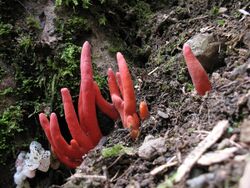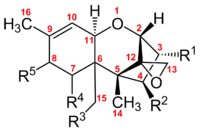Biology:Podostroma cornu-damae
| Podostroma cornu-damae | |
|---|---|

| |
| Scientific classification | |
| Kingdom: | |
| Division: | |
| Class: | |
| Order: | |
| Family: | |
| Genus: | |
| Species: | P. cornu-damae
|
| Binomial name | |
| Podostroma cornu-damae (Patouillard) Hongo & Izawa
| |
| Synonyms[1] | |
| |
| Podostroma cornu-damae | |
|---|---|
| Mycological characteristics | |
| smooth hymenium | |
| no distinct cap | |
| hymenium attachment is irregular or not applicable | |
| stipe is bare | |
| spore print is yellow to brown | |
| ecology is saprotrophic | |
| edibility: deadly | |
Podostroma cornu-damae (Japanese: カエンタケ Hepburn: kaentake), also known as the poison fire coral,[2] is a species of fungus in the family Hypocreaceae. The fruit bodies of the fungus are highly toxic, and have been responsible for several fatalities in Japan. The fungus contains several trichothecene mycotoxins.
Taxonomy
The species was originally described as Hypocrea cornu-damae by Narcisse Théophile Patouillard in 1895,[3] and later transferred to the genus Podocrea in 1905 by Pier Andrea Saccardo.[4] In 1994 Japanese mycologists Tsuguo Hongo and Masana Izawa placed the species in the genus Podostroma.[1]
Range
The fungus was once thought to be only native to Korea and Japan, but recent discoveries have been made in Indonesia (Java), Papua New Guinea and some parts of Australia.[2][5][6]
Description
The conidiophores (specialized fungal hyphae that produce conidia) are up to 400 μm high and about 2–4 μm wide in the main axial hyphae. The phialides are arranged in tufts with narrow angles at the top, similar to the branching hyphae found in Trichoderma species. The conidia are roughly spherical with a truncate base in each spore, pale green in color, and measure 2.5–3.5 μm in diameter. Their surfaces are almost smooth, but sometimes appearing very faintly roughened with light microscopy.[7]
Toxicity
Several poisonings have been reported in Japan resulting from the consumption of the fungus. In 1999, one of a group of five people from Niigata prefecture died two days after consuming one or two grams of fruit body that had been soaked in sake. In 2000, an individual from Gunma prefecture died after eating the fried mushroom. Symptoms associated with consumption in these cases included stomach pains, changes in perception, decrease in the number of leukocytes and thrombocytes, peeling skin on the face, hair loss, and shrinking of the cerebellum, resulting in speech impediment and problems with voluntary movement.[8] In another instance, an autopsy revealed multiple organ failure, including acute kidney failure, liver necrosis and disseminated intravascular coagulation.[9] In one case of poisoning, the patient suffered from hemophagocytosis, in addition to severe leukocytopenia and thrombocytopenia, seven days after ingesting the fungus. Plasmapheresis and administration of granulocyte colony-stimulating factor were used to treat the blood abnormalities. The authors suggested that these treatments, in addition to the large volume of administered intravenous saline - 9 liters (2.0 imp gal; 2.4 U.S. gal) over a 12-hour period—were responsible for his successful recovery.[10]
The poisoning symptoms are similar to those observed previously with animals that had consumed trichothecene mycotoxins. Japanese researchers detected the presence of the macrocyclic trichothecenes satratoxin H, satratoxin H 12′,13′-diacetate, satratoxin H 12′-acetate, and satratoxin H 13′-acetate. When grown in liquid culture the fungus additionally produces roridin E and verrucarin J. With the exception of verrucarin J, a 500-microgram dose of any of these compounds, when injected into the abdomen of mice, will result in their death the following day.[8] It has been claimed that touching the fungus can cause skin irritation,[6] but this is controversial.[11]
See also
- List of deadly fungi
- List of poisonous fungi
- Mycotoxicology
- Trichothecene
References
- ↑ 1.0 1.1 "Podostroma cornu-damae (Pat.) Hongo & Izawa 1994". MycoBank. International Mycological Association. http://www.mycobank.org/MycoTaxo.aspx?Link=T&Rec=307789. Retrieved 2010-10-20.
- ↑ 2.0 2.1 Smee, Ben (2019-10-02). "Deadly fungus native to Japan and Korea discovered in Australian rainforest" (in en-GB). The Guardian. ISSN 0261-3077. https://www.theguardian.com/science/2019/oct/03/deadly-fungi-native-to-japan-and-korea-discovered-in-australian-rainforest.
- ↑ Patouillard, N. T. (1895). "Enumération des Champignons récoltés par les RR. PP. Farges et Soulié, dans le Thibet oriental et le Su-tchuen" (in fr). Bulletin de la Société Mycologique de France 11: 196–99. https://commons.wikimedia.org/wiki/File:Enum%C3%A9ration_des_Champignons_r%C3%A9colt%C3%A9s_par_les_RR._PP._Farges_et_Souli%C3%A9,_dans_le_Thibet_oriental_et_le_Su-tchuen.pdf.
- ↑ "Supplementum universale. Pars VI. Hymenomycetae-Laboulbeniomycetae" (in French). Sylloge Fungorum 17: 799. 1905.
- ↑ Mounter, Brendan; Thompson, Jesse (2019-10-03). "Deadly Asian fungus, poisonous to touch, found in Far North Queensland rainforest" (in en-AU). ABC News. https://www.abc.net.au/news/2019-10-03/deadly-fungi-poison-fire-coral-found-in-far-north-qld/11571162.
- ↑ 6.0 6.1 Burt, Jemima and Mounter, Brendan (2021-02-19) Deadly fungus, poison fire coral, sighted near Cairns, prompting warning for bushwalkers ABC News, 2021-02-19.
- ↑ "Revision of the Hypocreales with cultural observations. V. Podostroma giganteum Imai, P. cornu-damae (Pat.) Noedijn and Hypocrea pseudogelatinosa sp. nov". Reports of the Tottori Mycological Institute (Japan) 10: 421–27. 1973.
- ↑ 8.0 8.1 "Toxic principles of a poisonous mushroom Podostroma cornu-damae". Tetrahedron 57 (39): 8277–81. 2001. doi:10.1016/S0040-4020(01)00824-9.
- ↑ "Case report: food poisoning to death by Podostroma cornu-damae, its case history and autopsy findings" (in Japanese). Acta Criminologiae et Medicinae Legalis Japonica 69 (1): 14–20. 2003.
- ↑ "[Successful treatment in a case of Podostroma cornu-damae poisoning, a deadly poisonous mushroom]" (in Japanese). Chudoku Kenkyu 15 (2): 177–82. 2002. PMID 12108023.
- ↑ "Fire Coral Fungi | Podostroma cornu-damae" (in en). http://www.rjgrayecology.com/2/post/2019/10/mycophobia-and-the-fire-coral-fungi.html.
External links
- Kingdom of Fungi - Podostroma cornu-damae jpg
- Japanese blog images
- South Korean images, including one that looks like a four-fingered hand
Wikidata ☰ Q864070 entry
da:Kødkernesvamp-familien
 |


